A Much-Traveled Southerner on Collecting and Memory
As told to Teresa Nicholas
Sam B. Olden was born in Yazoo County, Mississippi, on a cotton plantation known as Coon Camp, on March 27, 1919. While still an infant, he moved with his parents into Yazoo City, where he spent his childhood and adolescence. After finishing his studies at the University of Mississippi, in 1941, he lived primarily overseas until returning to Mississippi in 1974. During these thirty-three years, he served in the American Foreign Service, the U.S. Navy, and the Central Intelligence Agency, and later worked for the Mobil Oil Corporation in West Africa, Tunisia, Algeria, Peru, and Spain. Especially while in Peru and Spain, he became a serious collector of art and handicrafts, including paintings, ceramics, copperware, furniture, and straw work. He’s continued to collect things from all over the world and has visited 160 countries.
Sam, who has bright hazel eyes and a wide, frequent smile, appears many years younger than his age. He retains a keen interest in history and speaks three foreign languages, having learned Spanish, French, and German while abroad. Recently, I met with him in the sitting room of his grandfather Olden’s Victorian house in Yazoo City, which he now calls home, the gracious, wallpapered rooms serving as a repository for his oldest, fondest memories. During our visit, he spoke with me about the early influences on him, and later he walked me through the house to show me some of his cherished collectibles.
I understand that your maternal grandfather started farming Coon Camp right after the Civil War. How did the plantation get its name?
Apparently a group had gone hunting around 1850 on the land that became Coon Camp. That night the raccoons stole all of their rations. So when they finally cleared the land and made a plantation out of it they called it Coon Camp. I was born on Coon Camp, because my mother inherited it when they broke up my grandfather’s holdings after his death in 1910. By that time, he had become probably the biggest planter in the Delta section in Yazoo County. So my mother and her eight siblings each inherited about five hundred acres. And my father, a city boy who’d never planted a lick of cotton in his life, decided since he had married a “landed heiress,” that he was going to raise cotton, too. However, he’d always loved automobiles and finally he gave farming up and went into the automobile business. They lived out there for five years after they were married, and he was quite successful. But after I was born, they decided to be nearer their young friends and moved into town. So that is why we came into Yazoo City when I was eleven months old, although I was born out in the Delta.
What was life like growing up in Yazoo City during the 1920s and 1930s?
I can only remember the pleasantness and the happiness of those years, beginning with the euphoria right after the world war, in the earliest of the ’20s, when I began to be conscious of things. We moved into a neighborhood on North Street. And it was just alive with children, all of whom were close friends. Every day when I would walk down the steps I had people waiting to play. Across the street were a series of huge front yards that we could play in, with sand piles and things like that. It seemed to have everything that a child could want—even a shallow creek at the end of the street we called the “bayou,” where we would go in the summer and catch crawfish. My house was two and a half blocks from the Main Street School, to which I first walked in one direction, and then two and a half blocks to the high school, which I later walked to in the other direction. It was just beautifully located. And the Yazoo City school system, though segregated, was recognized as excellent. So it was most happy and most enjoyable, and I have a loving memory of my growing up here.
What did you study at the University of Mississippi? How did you come to enter the Foreign Service?
I went to Ole Miss in 1935, when I was only sixteen years old. I decided, because I didn’t know what I wanted to do in life, to take the B.A. course, and because of my interest in history of any type, any country, anywhere, I decided that my major would be history, with a double major in English. We had wonderful professors at Ole Miss at that time in both the History and English departments. One of these was Bell I. Wiley, who came finally to be the head of the History Department at Emory University. Dr. Wiley had done so much original work in Civil War history, which was his great interest, he was finally elected president of the Southern Historian’s Association. I feel he really more or less created the field of Southern history, and we were devoted friends until he died. I wouldn’t take anything for my training in history there, and it’s meant a world to me the rest of my life.
I did graduate in 1939 with a double major in English and history. And then I decided to go ahead for a graduate degree in Southern history. But shortly before returning to Ole Miss to start my graduate studies, the chancellor, as we called the president, who was a great friend of mine, and who’d encouraged me to come back for graduate study and wanted me to get a doctorate at Yale, just as he had, and be a professor, invited me to become a student assistant teacher to give the Survey of American History course, a requirement for all incoming students in the business school. I had just three weeks to prepare. I was given the textbook that they used and had to quickly brush up on some small details of American history, but I accepted. And I carried it off pretty well, learned how to bravely face and gain the attention of fifty freshmen only a few years younger than me, and to watch my language. I began to put g’s on the end of gerunds and participles, made myself enunciate more clearly, as I had to be heard in a huge hall on the second floor of the antebellum Lyceum, a historic building with acoustics not really up to date. But I apparently was a success, for the second year I was there they asked me to teach two classes in American history for freshmen.
So I got the master’s in May of 1941. However, at the beginning of that second year, I had applied for a job with the U.S. State Department, because although I still had teaching in mind as a possible career, I had nevertheless been intrigued by a possibility that by chance opened for another one. There was a bulletin board in the Lyceum, but there were seldom mail items and announcements of interest stuck on it. Today these are plastered with notices of foreign scholarships, opportunities to study abroad, and so on. But not then. One day, however, there was an announcement by the U.S. State Department that it was offering positions in the American Foreign Service. The Second World War had broken out in Europe by that time, and they were trying to beef up the Foreign Service, which had been traditionally very small. Applications for future positions were being accepted, so I prepared one. With the support of then powerful Mississippi senator Pat Harrison, I was accepted, so within two months of graduating in June 1941, I was steaming through the Panama Canal, heading down to Ecuador.
My initial assignment in the U.S. legation at Quito was as a clerk. But six months later, in December 1941, our country entered the war. All legations in South America were elevated to embassies; my boss became an ambassador, and at his request I was promoted also, to the rank of vice consul. After a year, though, with constant news of all my old friends joining military service, three killed in aviation training accidents, I felt I could no longer stay in my safe civilian job. I gave the State Department my resignation and applied for a commission in the U.S. Navy.
Sam served three years in the navy, from July 1943 to July 1946. During that time, he was mainly in Le Havre, France, with the unit operating the port through which most of our troops and war matériel were pouring into Europe after D-Day. When the European fighting ended, in May 1945, he was transferred from Le Havre to the office of the naval attaché in the U.S. embassy in Paris. He would spend six more months in the service in Europe, until transferred to Pearl Harbor for a final six months, during which he spent time in Japan and China. He entered the navy as an ensign and departed in July 1946 as a full lieutenant.
Did your experiences as a young adult in Mississippi influence your decision to join the Foreign Service and the navy?
Not as a young adult, but most certainly as a child, and I give credit to my two grandmothers, my father’s mother [Catherine Kennard Olden] and my mother’s mother [Sarah Addie Johnson Clark], both of whom I was devoted to. But two ladies could never have been more different. I guess it was my father’s mother who influenced me the most. She was from Port Gibson [Mississippi], and she was a music lover and a poet and had gone to Whitworth College to study classical piano in the early 1880s. Even as an older woman she composed music and played the piano, right in this room, right where I’m sitting. She won many prizes for compositions from the Mississippi Women’s Clubs. She loved to play and ran up and down the keys dramatically. It was romantic music that she particularly loved, and she wrote very romantic poetry, too. She interested me in a set of books we had in this house entitled Stoddard’s Lectures. He was a world traveler who had gone to all sorts of countries and had written about them. I couldn’t read much of it because I wasn’t old enough, but it was full of illustrations of cathedrals and monumental structures in Europe and people in interesting native costumes and things like that. I can still recall that thick old paper; it had sort of a sour smell. I wish I still had that set. I was fascinated by all of these other countries and the idea of different languages, and so I had that early influence and introduction to music and to poetry and to things foreign, from that grandmother.
Now, my mother’s mother had always wanted to travel, but raising ten children and running a large plantation home, she had not had many opportunities. So she decided in 1910 to make the European tour she had always longed for. She was gone five months. And for the rest of her life, she loved to tell stories about what she had done in Europe. And I loved to go out to her big antebellum home on her planation, Linden, in the summer and stay for weeks at a time when I was ten, eleven, twelve. And over and over I would listen to Big Mama’s tales of what she had done in Europe, and I was beguiled. She finally broke down and gave me, and I promptly misplaced them as a little boy, the stickers advertising hotels that she had saved from the trunks she used for carrying big hats and other things around with her. All that, of course, made a huge impression on me.
Finally, in the Ricks Memorial Library [in Yazoo City], when I started school next door, there was a little brown set of books named the Our Little Cousin series, each about a child in a different faraway country, and I devoured those things. There must have been twenty of them. And I read them all. Anything foreign fascinated me beyond words, and I’m sure it was the influence of my grandmothers. Certainly something seized my imagination about traveling even at that age and has kept me seized the rest of my life.
You continued to serve your country during the late 1940s and early 1950s. Can you describe your role with the Central Intelligence Agency?
No, because I took a secrecy oath when I resigned after five years to join the Mobil Oil Corporation. But I can tell you how I got into that work. When I left Paris, I joined a group of ten naval officers from other points around Europe who were being sent back to the States at the same time. We were put on a small Liberty ship with returning soldiers, which was tossed around in one of the worst winter storms that many could remember, and eight out of the ten naval officers in my group got so sick they couldn’t get out of their bunks. But one other guy and I for some reason didn’t get sick, so Ray [Raymond G. Leddy] and I would get up every morning, put on full uniform, and make it down to the mess, where breakfast was being served. Of course, the ship would tilt so extremely that all the eggs and bacon would sometimes slide down on the floor. So all we had to do was talk all the way over. And I didn’t know it, but he was an OSS [Office of Strategic Services] officer who had been in Spain, and he knew how to debrief people, so he knew everything about me before we landed. We became great friends on that ship, and then I went on to Hawaii and had my last six months of duty out there.
Again a civilian and back home, I had a wonderful time reading and getting back in touch with my family for about four months, when, surprisingly, a special delivery letter arrived. It was quite mysterious, saying something like, “You have been recommended to us as one who because of known loyalty to his country might be interested in cooperating with us in a new organization the likes of which our country has never had before, and will be a part of our national defense system. If you would be interested in talking to us, let us know and we will invite you to Washington for an interview.”
A trip to Washington? Fine! So I wrote back agreeing, and soon I was in Washington, approaching the meeting place assigned me, near the Lincoln Memorial, in a temporary wartime building that has since been torn down, right near where the Watergate complex is. Expected by guards at the door, I was escorted to an office down a long corridor, where, sitting there behind his desk, grinning and laughing, was Ray, my buddy I had talked to all the way across the Atlantic. He had been given a top job with the Central Intelligence Group, predecessor of the CIA, and had been given responsibility for organizing operations in South America, and wanted me to work with him.
I joined and worked with him in Washington for the next two years, during which we became the CIA. I then told Ray I was ready to do some fieldwork, but really didn’t want to go back to Latin America, but to Europe, where my heart was. He said he understood and suggested I go talk to Richard Helms, in charge of European operations, who was to become head of the CIA years later. With offices right down the corridor from each other for two years, we had become good friends, and during some evenings in his home, he had made me a great martini.
So I talked to Dick, and on the Fourth of July 1949, my train rolled into a dimly lit, shabby, still partially war-torn Vienna, as yet in the Russian zone of an Austria occupied by four Allied powers. I came to love Vienna and worked there until mid-1951. Though forlorn, it still had music, theater, museums, marvelous imperial buildings, palaces, Baroque churches, and its grand history. Renovated and ever more beautiful when I go back today, it remains my favorite foreign city.
Nevertheless, while in Vienna Sam began to realize that temperamentally he was not cut out for a long career in intelligence work. By chance he often met with a local representative of the Mobil Oil Corporation, which had had a refinery near Vienna that the Russians had taken over and had barred from any American inspection. Through contacts, Sam could tell the Mobil representative much about what the Russians were doing there. The result was that his Mobil friend told him that if he ever decided to change professions, he should contact company headquarters in New York.
In mid-1951, when Sam was about to be transferred, possibly to Korea, he decided it was the right moment to leave the CIA. He was quickly employed by Mobil in New York to work in the West African colonies of Great Britain and France, and in early 1952 landed in Lagos, Nigeria. He traveled throughout Nigeria and the British Cameroons until 1955, when he was transferred to Brazzaville, French Congo; then to Yaoundé, French Cameroon; and finally to Bangui, French Colony of Oubangui-Chari.
From 1957 to 1961, he was in the Mobil Government Relations Department in New York and served as Mobil’s observer at the United Nations. He returned to North Africa in 1961 as general manager of Mobil’s affiliate in Tunisia, then in 1963, as general manager in Algeria. From 1966 to 1969 he was general manager of two Mobil affiliates in Lima, Peru, and from 1969 to 1974 was general manager in Madrid, Spain.
You have told me that while you lived in Africa you did not collect anything more than what you could put in a suitcase. But in Peru that changed, and you began acquiring artwork and ceramics. Which objects are most dear to you?
I display as many of them as I tastefully can in my home here. And I have given many others to my sister, my niece, and my nephew for their homes. Foremost, of course, is my collection of about 125 pieces of pre-Columbian, pre-Inca ceramic artifacts presently in the Mississippi Museum of Art in Jackson. I have donated about fifty pieces to it, and the rest are on extended loan, many displayed beautifully in a series of wall showcases near the entrance.
They are mainly ceremonial vessels of several shapes, and figures of persons, animals, fruits, demonic creatures, and more, all of beautiful clay, wonderfully shaped in molds, then painted or covered with drawings and glazed. They come from several successive civilizations in Peru that from about 1200 b.c. to 1400 a.d. had flourished, fallen, and been buried and forgotten until brought to light again by a German archeologist, Max Uhle, around 1900. I have examples from the Chavín, Cupisnique, Vicús, Salinar, Moche, Nazca, Lambayeque, Chimú, and Tiwanaku cultures, but I love my Moche pieces the most. I only learned this history after arriving in Peru from Algeria in 1966 and became totally fascinated by it. I bought my artifacts from dealers in Lima before 1969.
Now here in the house I have three paintings very special to me: two are primitives from Cuzco, probably done by natives taught by Spaniards, and one is from the Lima School. We walk into the living room and stand before a small oil painting of St. Bernard of Clairvaux. This is one of the Cuzco paintings. You know it’s St. Bernard because of the small medieval beehive on the book he is holding, symbol of a builder, in his case, of monasteries. I find its naiveté charming, with the birds not flying very gracefully around and one about to hit his head, and all the little flowers around his feet very stiff and unnatural. The art shop in Lima where I found it believed it to be early seventeenth century.
We walk into the dining room, where two very large oils hang opposite one another. I find the two frames you see almost as impressive as the paintings. I had them made by a firm of artists in Lima, which specialized in replicas of colonial furniture. They are based on heavy European Baroque styles, but modified for local taste for more color and glitter. One is ten inches wide, the other six, with red coloring, and literally hundreds of small mirrors are imbedded in the gilding. The firm also made for me several pairs of colonial-style candlesticks, beautifully carved, gilded, and full of small mirrors, too.
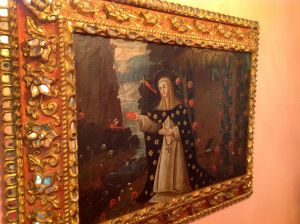
Primitive painting St. Rose of Lima, shown in her grotto-chapel, late 17th century. Photo by John Langston.
The larger painting, a primitive, is of St. Rose of Lima, the first American saint, canonized in 1671, shown in her grotto-chapel, where she lived in seclusion. Again you see the awkward birds and an overabundance of puffy roses. But it is a lovely painting. It too is from Cuzco, and probably late seventeenth century also.
The third painting is a “Purísima” (“most pure”), depicting the Roman Catholic doctrine of the Immaculate Conception, or the belief that the Blessed Virgin Mary was born without original sin. She stands on a crescent moon, a symbol also used with Astarte and Diana of Ephesus (both honored as virgins in prior religions), her heel crushing the serpent’s head. It is probably from the eighteenth century, when Spanish viceroys invited Italian painters to come teach in Lima. The work is much more sophisticated and to me shows the influence of El Greco in the long, curving body, and the sweetness of Murillo.
Next we walk into Sam’s bedroom, where primitive ceramic pieces rest on the mantel. These came from a village high in the Andes, near Ayacucho. The overly fat cows are traditional water jars made by the native people in a contemporary style. There were no cattle in South America until brought in by the Spanish conquerors in 1532, and the fascination for them, especially the bulls, is still passed on in local pottery forms. I have a pretty little bull right now on my breakfast-room table from the village of Pucará, which specializes in making them.
- Figures from the city of Ayacucho made by native potters. Photo by John Langston.
- Water jar of bull from the Ayacucho. Photo by John Langston.
- Candelabra of Huacasiki, Incan traditional figure. Photo by John Langston.
He points to another, more fantastical animal. On this curious candelabra base you have a Huacasiki. It is a demon once believed to hide in wooded gulches that could cry like a baby. If a mother had to walk through or even near one of those gulches with her baby on her back too near dark, the Huacasiki would cry and lure away the baby’s soul. But to show they had become Christian and no longer feared him, he now has a little church perched on his head.
Let’s move on to Spain, another country from which you have extensive collections, including ceramics from Talavera de la Reina, copper pieces, straw animal figures from Úbeda, and even medieval-style diningroom furniture from your house in Madrid. What can you tell us about some of these?
First, let’s talk about the ceramics, all Spanish. I have numberless pitchers of all sizes, the largest one for serving Sangria. They are all attractively decorated and colorful, especially the fine ones from Seville. My sister now has at least five, and I gave my nephew’s family an enormous, heavy ceramic punch bowl with twenty little Sangria pitchers in holders around the entire rim. Look at that huge matched pair over two feet tall. Very impractical, but so pretty.
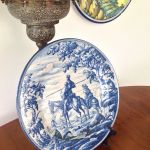
Particularly beautiful specimen of Talavera de la Reina ceramic depicting Don Quixote attacking the windmills. Photo by John Langston.
I have ceramic candlesticks galore, open-sided colorful lanterns for candles, bells, platters, and small covered jars, a few with contemporary geometric patterns, even a large umbrella stand with a charming hunting scene around its side. Those large platters are designed mainly to hang on walls as decorations. I got them on several visits to the famous pottery factory at Talavera de la Reina in central Spain, which is several centuries old. The images are from episodes related in Don Quixote. On my very first visit there, in 1945, I bought this one. He points to an all-blue-and-white platter, hanging near the kitchen window. The finest work of all, also of Don Quixote about to attack the windmills.
Also here is a decorated tile collection, mostly too from Talavera. These are the coats of arms of the oldest cities in Spain—Zamora, Córdova, Teruel, Guadalajara–twenty-three of them. On that wall are tiles with only portions of scenes on them to be made into a mosaic portrait. Normally they would be pressed into fresh plaster at the entrance of a new house or near a fountain. I bought them loose and had them mounted on plywood. That one is St. Isidro, patron saint of farmworkers. He was a pious field hand who often felt the need to kneel in prayer, leaving his plow. His boss told him if he didn’t stop all that praying and get to plowing, he’d fire him. So, as the picture shows, the next time it happened an angel came down to continue the plowing for him. The second is of St. Anton the Abbot, one of the first hermit monks in the 300s. He had a pig for company, just as St. Jerome in paintings always kept a lion for his companion.
We go from ceramics to copper. I began collecting copper utensils in Algeria and continued in Spain. Much of it is very artistic in a heavy sort of way. I have large trays—this one is at least 40 inches in diameter—and interesting copper braziers, which you would put hot charcoal into and stick under a table covered with a floor-length, thick cloth so your feet would keep warm in a cold room. They use braziers for heating in the winter all over Spain.
Sam points out copper water jars from Spain and all around the Mediterranean, hanging lamps from Turkey, teapots from Morocco, and covered couscous dishes from Algiers. In his library upstairs there can be found many more objects, all mementos from a lifetime of travel: prayer wheels from Tibet, daggers from Azerbaijan and Georgia, a handsome amber necklace he purchased for his mother in Danzig, silver gaucho spurs from Uruguay. Some have more than sentimental value, including a prized court order from Queen Isabella of Castile, signed by her at Granada in 1501: “Yo la reina, Ysabel.”
How did you get all these things back to Mississippi, including the large pieces of Spanish furniture, such as the diningroom table and big red Catalan chairs, the sideboard, and the two chests and small tables in your bedroom?
Being a general manager for Mobil had its perks. Coming home from Spain, I had only to stand by while Mobil had professional packers do the job, and with no limit on the cost: the truck that finally delivered all of it to Yazoo City had two trailers.
Sam arrived back in Mississippi in December 1974. For a time he enjoyed owning and overseeing a cattle ranch outside of Yazoo City. He also served twice on the board and as president of the Mississippi Historical Society and fifteen years on the State Committee for the Center for the Study of Southern Culture at the University of Mississippi. He renovated and improved the Yazoo Historical Society’s museum, which is named for him, and designed and oversaw construction of the Yazoo Memorial Literary Walkway, which honors more than one hundred local published authors.
How do you feel today when you look at these wonderful items from your adventures around the world?
My reason for having so much displayed around me is not only for their beauty and interest, but also to every day bring back my memory of the country, the time, and the events—usually very happy and often exciting—that led me to find and acquire each object. And, going on ninety-seven and slowing down, believe me, I’m reliving my memories more and more.
Interview by Teresa Nicholas. Teresa is a freelance writer living in Jackson, Mississippi. Her memoir, Buryin’ Daddy, was published in 2011 by the University Press of Mississippi. In March 2016 the Press will publish her biography of the writer Willie Morris.


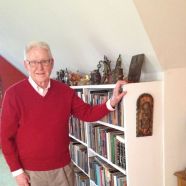





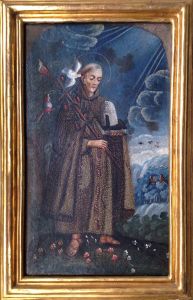
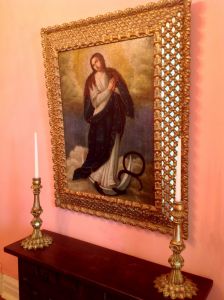
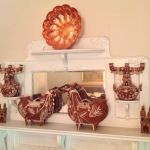

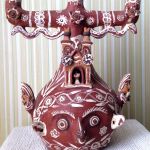
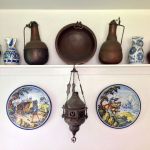
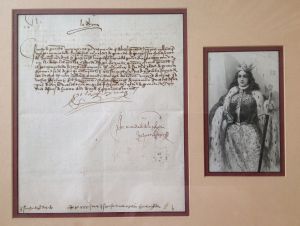
Another delightful and very interesting article written by Theresa
Wonderful article, Theresa, (great photos, John) about a fascinating and extraordinary man. I am so proud to know Sam Olden who has had an incredible influence on us all.
This was a very interesting article! Sam has
lived a very fascinating life. Sam’s description
Of his early boyhood years was particularly
fascinating. His Grandmothers influence in
him was of great interest to me. I have had the
pleasure of seeing his home and hearing about
some of his travels but this article really helped
me to see his life’s story.
Great story Theresa! My life has truly been enriched from knowing Sam and having many spellbinding conversations with him about his personal life story. A remarkable man I am honored to be able to call my friend.
Sam is my deceased mother’s first cousin, thus a first cousin to me. I loved the plantation, Linden and Sam enriched all the tales of Linden told to me by my mother’s mother, Annie Clark Lacey and Sam ….”as only Sam can bring life to that time of the past”
I was told so many remembrances of Linden plantation as a child by Sam’s aunt, my mother’s mother. Before television I could visualize many, many things about Linden. It was almost as if I had lived there. Sam’s yarns of Linden just add to the memories I heard as a child. When my family and I visit Sam, it is wonderful to hear of new tales of the life gone by but not lost in the memories. They last forever…..especially when related by Sam. So to my first cousin, once removed, I sa, using a borrowed line, “Thanks for the memories, Sam.”